How to Check for Parasites During Cat Grooming

Cats are naturally curious animals and great groomers, but even great groomers can get parasites.
Parasite infestations among cats are quite common and may not be easily detected during regular grooming.
That is why being aware of how to look for those tiny invaders is important.
Whether the issue is fleas, ticks, or ear mites, the ability to check for parasites during grooming will help protect your cat’s health and keep your home safe from infestation.
In this article, we take you through the important steps of searching for and eliminating parasites.
This way, you ensure that your cat stays free from parasites and lives comfortably.
Occasional grooming is not only about neatness but also about general health care.
Let’s now explore how you can turn your regular grooming routine into time spent examining your cat for parasites and what to look out for.
Table of Contents
Feline Parasites: What to Watch For
The most frequent parasites that infect cats include fleas, ticks, ear mites, and worms.
These parasites can cause anything from mild skin irritation to serious diseases in your cat.
While grooming is one of the best ways to prevent these pests, it’s equally important to know what you’re looking for during your routine.
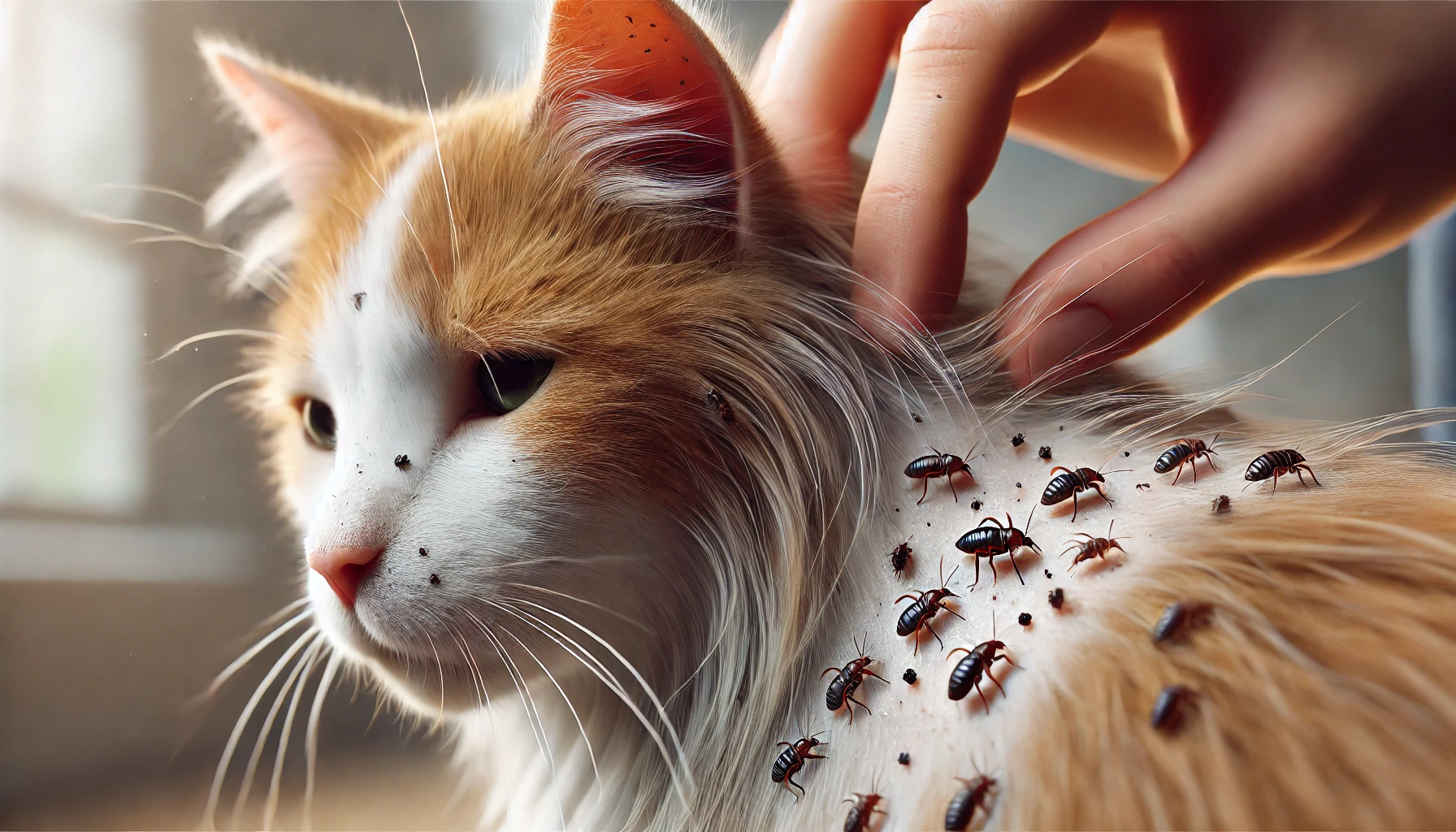
Fleas: Signs and Symptoms
Fleas are one of the most common parasites in cats.
These small, brown insects live deep inside your cat’s fur and feed on its blood.
Though small, they can cause big problems for your cat, including heavy itching, hair loss, and infections.
- Look for small, black specks in your cat’s fur, which may be flea dirt.
- If your cat has uncontrollable scratching or is biting into their fur, it may be a sign of fleas.
- Run a flea comb around the neck, near the tail, and over the body to catch those little critters hiding in the fur.
Fleas can also transmit tapeworms, so regular checks as part of your health routine are necessary to prevent further complications caused by these parasites.
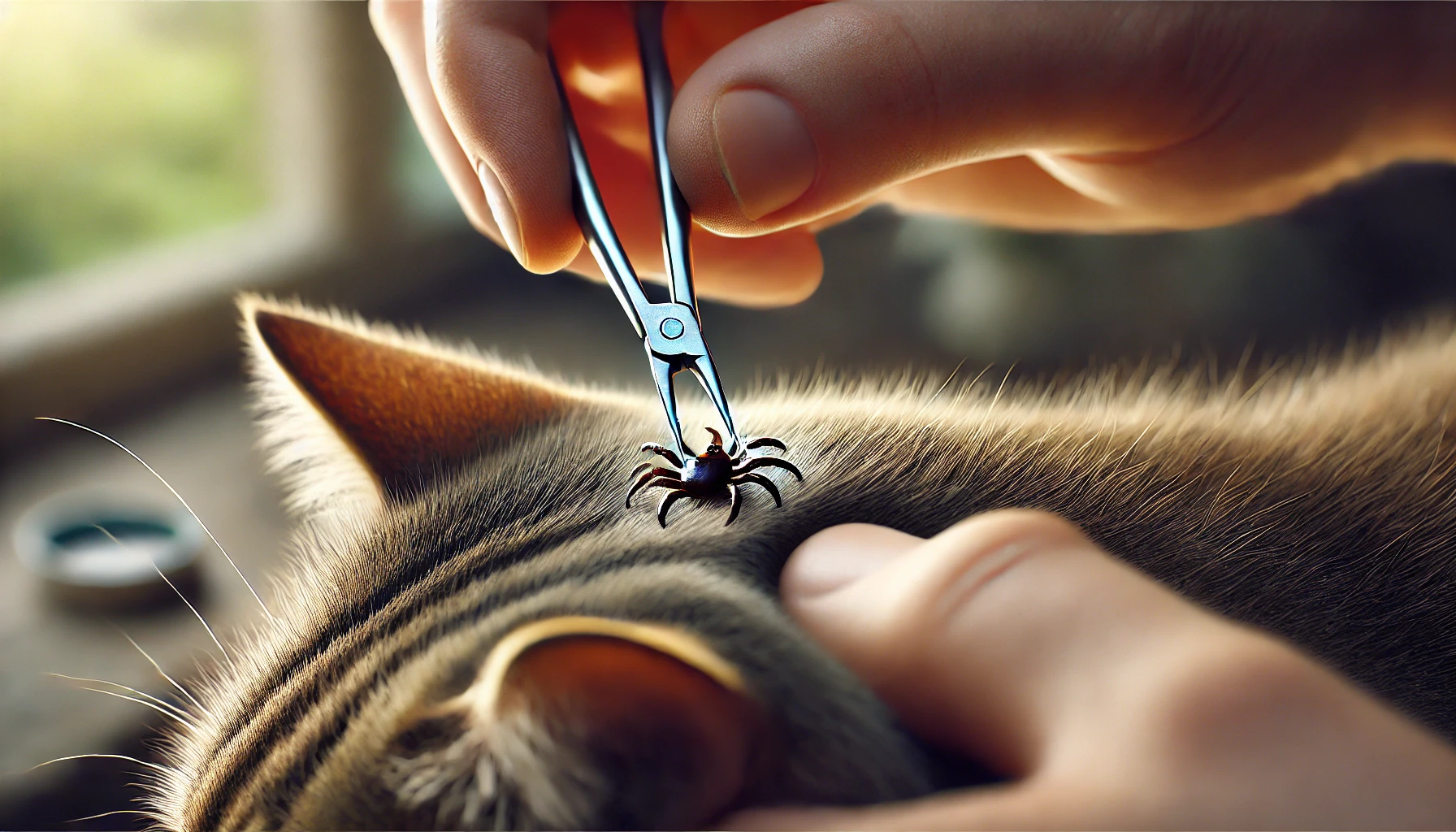
Ticks: How to Identify and Remove Safely
Ticks are not as common as fleas but can also cause major issues for your cat.
These parasites attach themselves to your cat’s skin and feed on their host’s blood.
In doing so, they may transmit serious diseases like Lyme disease.
- Give your cat a thorough check, especially around the ears, under the collar, and between the toes.
- If you find a tick, use tweezers or a special tick remover tool to gently pull it out without twisting.
- Ensure you remove the entire tick, as leaving parts of it behind can lead to infections.
Regular grooming provides the perfect opportunity to check for ticks before they cause harm.
Regular grooming can help detect fleas, ticks, ear mites, and worms early, preventing them from causing serious health issues in your cat.

Best Grooming Practices for Parasite Detection
Regular grooming not only makes your cat look neat, but it is also a highly effective method for detecting parasites.
You can easily prevent harm caused by many parasites, such as fleas and ticks, well in advance with regular grooming.
A few simple additions to your grooming routine can ensure that your cat remains parasite-free.
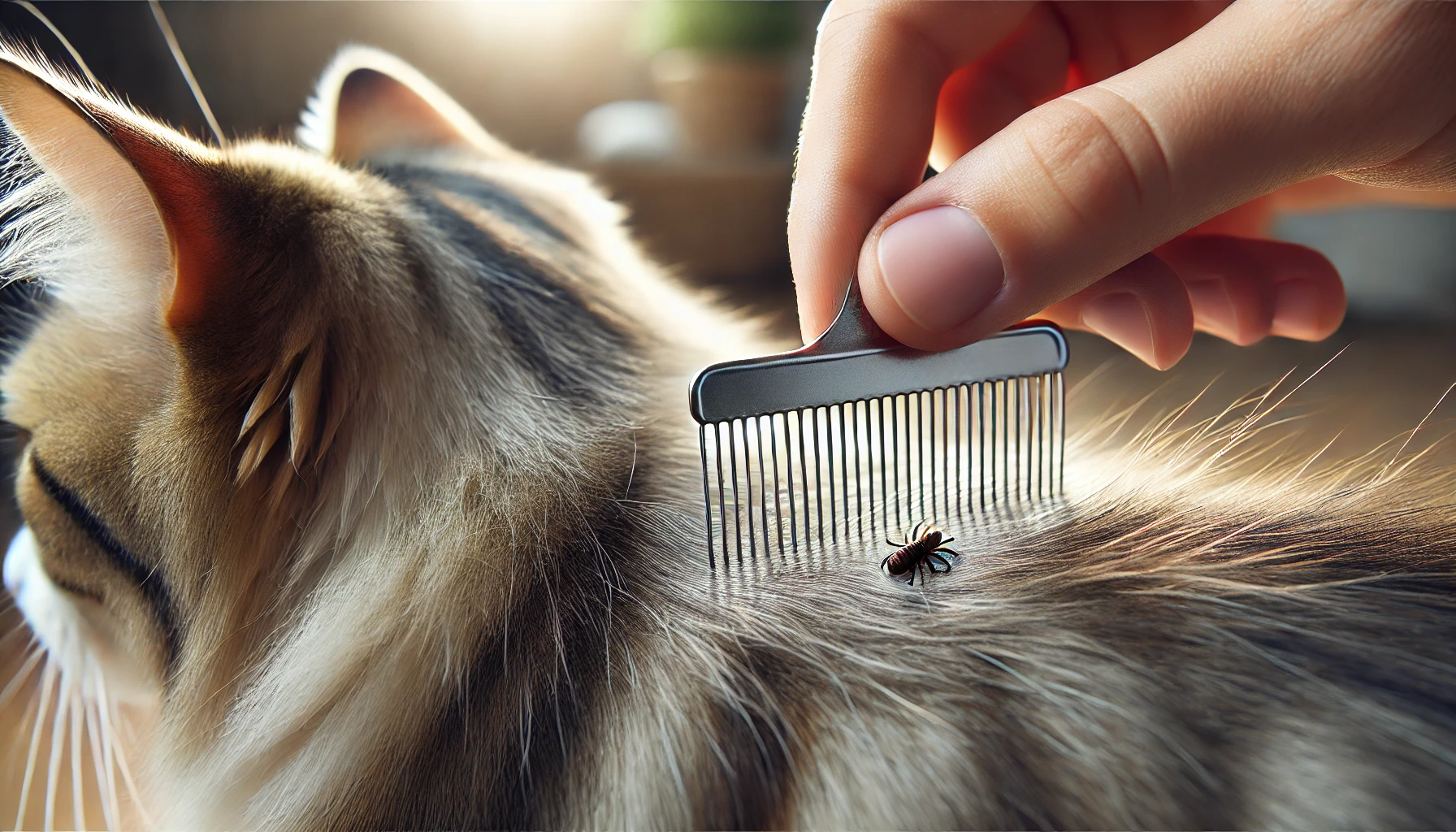
Using a Fine-Tooth Comb to Detect Fleas
A flea comb is one of the most efficient ways to check for fleas on your cat.
The comb’s narrow teeth catch fleas, flea dirt, and eggs, which may be hard to see with the naked eye.
When combing your cat, pay special attention to areas around the base of the tail, neck, and belly, as these are favorite hiding spots for fleas.
While combing, keep a bowl of soapy water nearby to dip the comb in frequently, killing any fleas instantly.
Fleas are notorious jumpers, and the soapy water helps trap them.
- Use a fine-toothed metal comb, as it is more durable than plastic combs and does a better job.
- Comb your cat’s fur slowly and gently to avoid causing discomfort.
- Pay extra attention to areas with thinner fur, where fleas are more likely to hide.
By incorporating flea combing into your regular grooming routine, you’ll be able to detect infestations early, preventing a full-blown outbreak.

Checking Your Cat’s Coat and Skin
While grooming, take a moment to examine your cat’s fur and skin for any signs of parasites.
Look for redness, bumps, or bald spots, which could indicate an allergic reaction to fleas or other parasites.
Run your fingers through the fur to feel for raised areas or lumps that might suggest ticks.
Be mindful of areas where your cat is excessively grooming, as this could be a sign of irritation caused by parasites.
- Part the fur in different areas and check the skin for signs of parasites or irritation.
- Inspect the ears, under the legs, and around the neck—these are prime areas for ticks to attach.
- If you notice any concerning skin conditions, consult a veterinarian for a proper diagnosis.
Regular inspections during grooming not only help you detect parasites but also allow you to monitor your cat’s overall skin health.
Incorporating a fine-tooth comb and regular checks for skin abnormalities can effectively keep your cat parasite-free.

How Parasites Affect Your Cat’s Health
Parasites can do more than just irritate your cat; they have the potential to significantly harm your cat’s overall health.
While some parasites might only cause minor discomfort, others, if left untreated, can lead to serious health complications.
Understanding the effects of fleas, ticks, ear mites, and worms on your cat’s health is crucial to take timely action and prevent long-term issues.

Impact of Flea Infestation in Cats
Beyond the itching and discomfort caused by fleas, flea infestations have more severe health repercussions.
Cats allergic to flea saliva may develop a condition called flea allergy dermatitis (FAD), which is characterized by acute itching, redness, and even bacterial skin infections.
Additionally, fleas can cause tapeworm infestations and anemia, particularly in kittens and older cats, when the infestation becomes severe.
Early detection and control of fleas are essential for maintaining your cat’s health.
- Flea allergy dermatitis (FAD) causes severe scratching, hair loss, and inflamed skin.
- Heavy infestations can result in anemia due to blood loss, which can be fatal for kittens and senior cats.
- Fleas can transmit tapeworms when ingested during grooming.
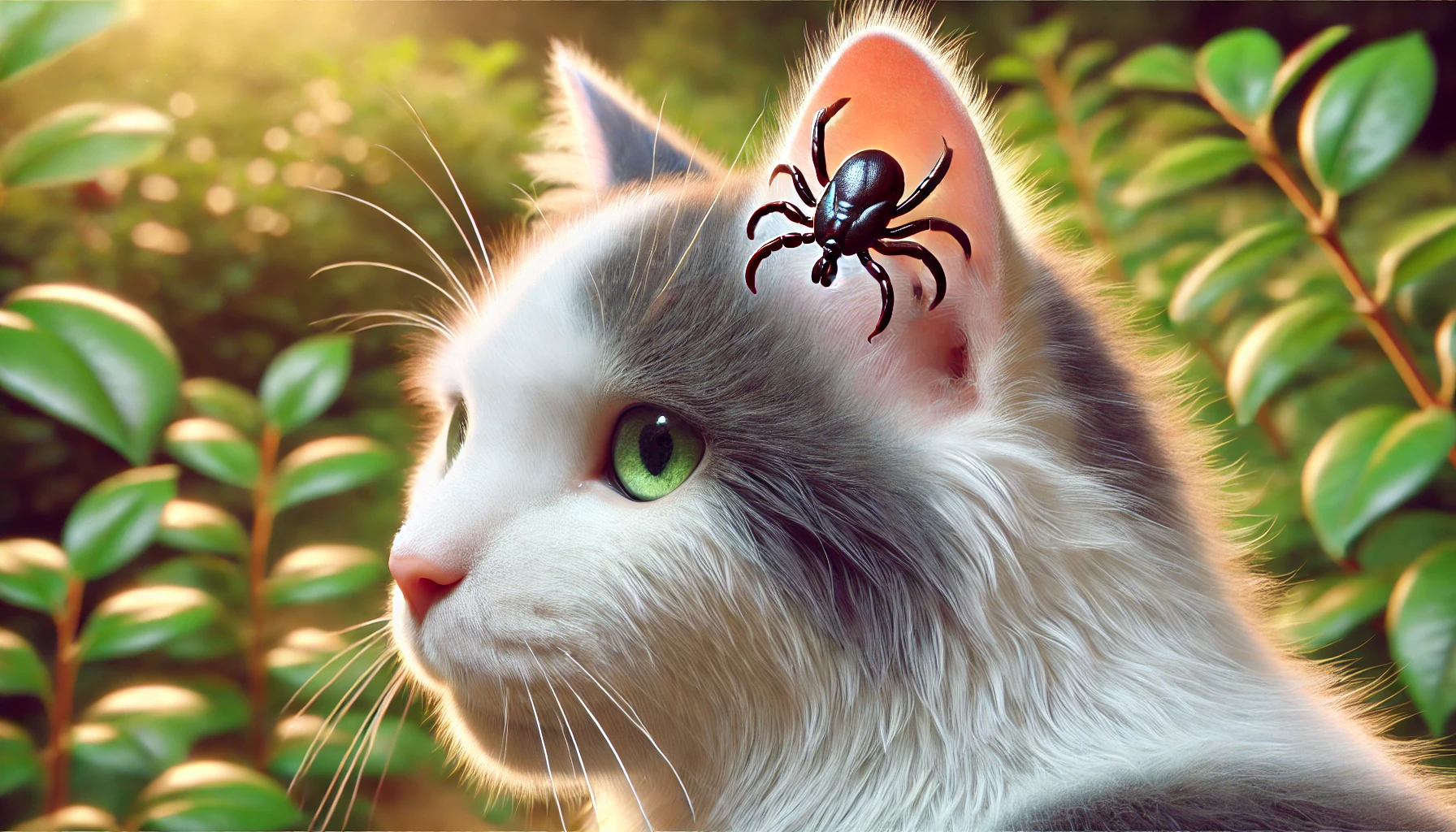
The Dangers of Tick-Borne Diseases
Ticks are not just a nuisance; they can also carry and transmit serious diseases to your cat.
Although cats are less likely to develop tick-borne illnesses than dogs, they can still contract infections such as Lyme disease, tularemia, and cytauxzoonosis.
Symptoms of these diseases include fever, lethargy, joint pain, and, in some cases, death.
It is crucial to remove ticks immediately and monitor your cat for any signs of illness following a tick infestation.
- Lyme disease: Causes fever, joint pain, and lethargy in cats.
- Tularemia: A bacterial infection that causes swollen lymph nodes, fever, and oral ulcers.
- Cytauxzoonosis: A severe parasitic infection that can be fatal if not treated promptly.
Regular tick prevention and routine checks are necessary to protect your cat from these serious diseases.
Parasites like fleas and ticks can cause serious health issues, including allergic reactions and infections, if left untreated. Early detection is crucial.

Regular Grooming Prevents Parasites
Grooming is not solely about keeping your cat’s coat shiny and clean; it is also one of the most effective ways to prevent parasites.
It helps you detect fleas, ticks, and other parasites early, allowing you to take appropriate action before the infestation becomes serious.
By adding a few simple steps and products to your cat’s grooming routine, you can significantly reduce the likelihood of infestation and ensure your cat stays healthy and comfortable.
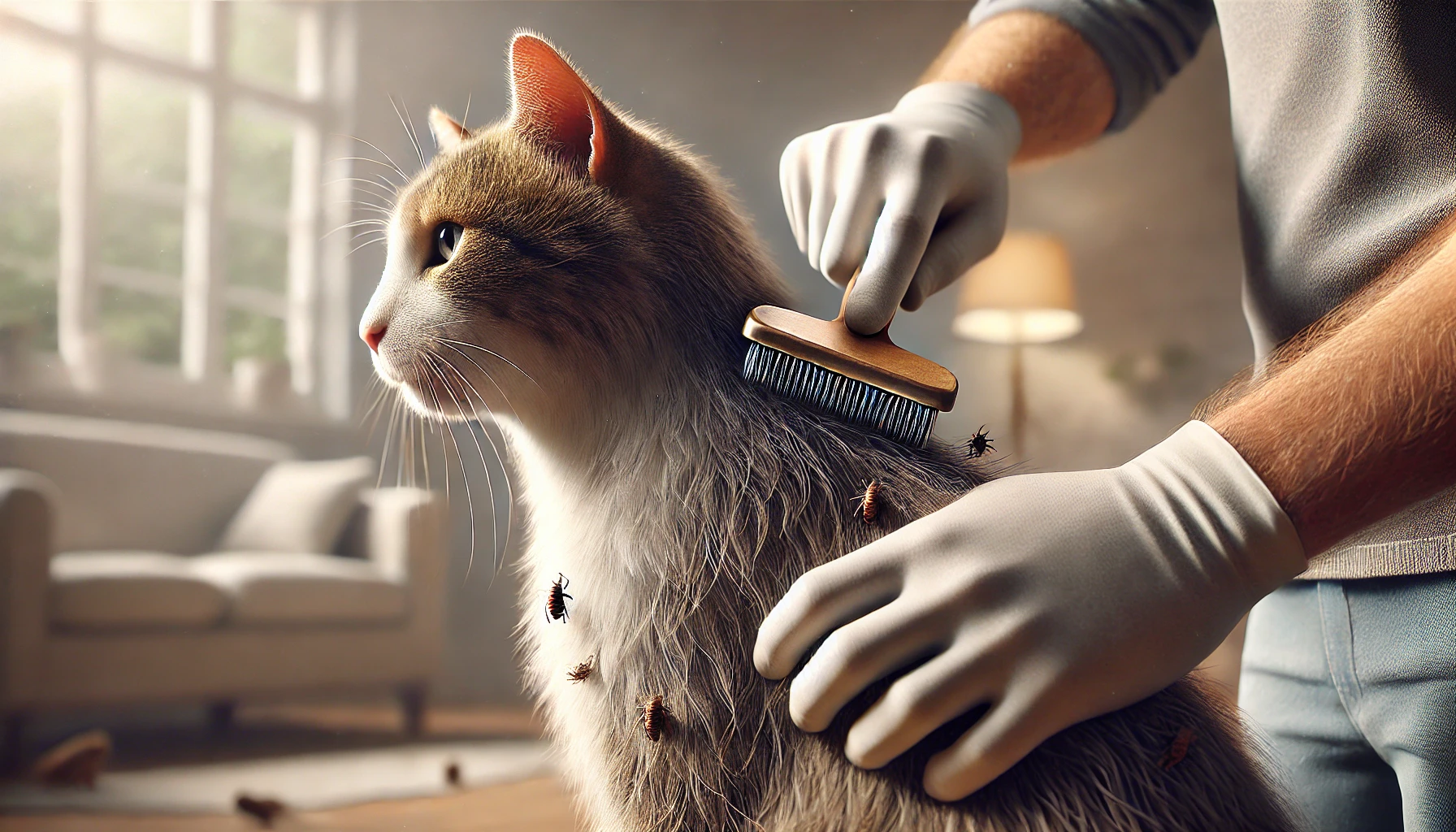
How Regular Grooming Helps in Parasite Prevention
Regular grooming allows you to inspect your cat for any signs of parasites.
Daily or weekly brushing removes dirt, debris, and loose fur that may harbor parasites or flea eggs.
It also provides an opportunity to observe any abnormalities, such as fleas, flea dirt, or ticks.
Cats with medium to long fur are particularly vulnerable, as their dense fur creates an ideal hiding place for parasites.
- Frequent brushing removes dead fur, reducing the chances of parasites hiding in the coat.
- Daily or weekly grooming makes it easier to spot fleas, ticks, and other pests early.
- Regular grooming allows you to monitor your cat’s skin for signs of irritation or other health issues caused by parasites.
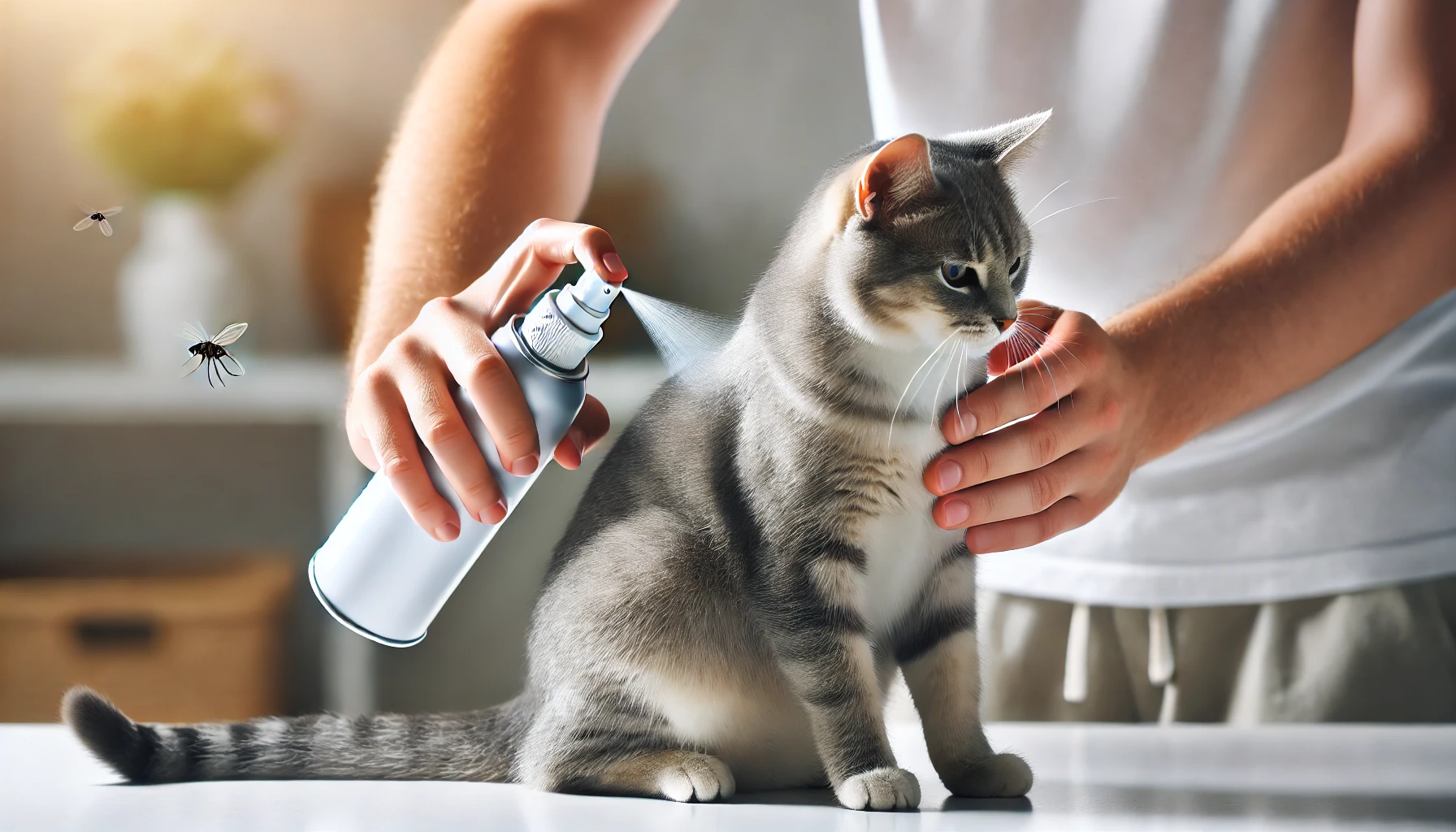
Using Parasite-Repellent Shampoos and Sprays
Another effective way to prevent parasites is by using parasite-repellent shampoos and sprays during grooming sessions.
These products typically contain ingredients like pyrethrin or essential oils that help repel fleas, ticks, and mites.
Bathing your cat with anti-parasite shampoo helps kill fleas and removes dirt and dander that can attract these pests.
- Choose a flea and tick shampoo formulated specifically for cats, as many dog shampoos are toxic to felines.
- Apply sprays directly to your cat’s fur, focusing on areas where fleas and ticks are most likely to hide, such as the neck, belly, and legs.
- Ensure the product provides protection between grooming sessions.
Using parasite-repellent products alongside regular grooming will help keep your cat free from parasites.

When to Seek Professional Help from a Veterinarian
While regular grooming is one of the best ways to prevent parasites, there are times when professional help may be necessary.
If your cat has a severe infestation, shows signs of illness, or if over-the-counter treatments are ineffective, it is important to consult a veterinarian.
They can recommend stronger treatments or prescribe medications to effectively eliminate the infestation.
- If your cat experiences recurring itching, hot spots, or inflamed skin, seek veterinary attention.
- Consult your veterinarian if your cat has a heavy flea or tick infestation that you cannot manage on your own.
- Your vet may prescribe long-term prevention medications in the form of oral or topical treatments.
Veterinary care is essential for managing severe parasite problems, especially when home remedies are insufficient.
Grooming plays a key role in preventing infestations by allowing early detection of fleas, ticks, and other parasites.

Common Myths and Misconceptions About Cat Parasites
There are various myths and misconceptions that, when taken as the truth, can lead to ineffective prevention or delayed treatment of parasites in cats.
Understanding the real facts behind these myths is crucial to keeping your cat parasite-free.
This section highlights some of the most common myths about cat parasites and how to debunk them, helping you make informed decisions for your pet’s care.

Myth: Indoor Cats Don’t Get Parasites
One of the most common misconceptions is that indoor cats are safe from parasites.
While it is true that outdoor cats are more likely to catch parasites, living indoors does not fully protect your cat from these threats.
Fleas, ticks, and other parasites can still enter your home through various means, such as on your clothes, shoes, or even from other pets.
Indoor cats can also contract parasites from windowsills, houseplants, or an occasional mouse or insect that makes its way indoors.
Regular grooming and parasite prevention treatments are just as important for indoor cats to keep them protected.
- Fleas can be carried into your home by other animals or people.
- Ticks can hitch a ride on shoes, clothes, or other pets.
- Parasites like fleas and mites can survive in carpets, furniture, and bedding, making infestations easier indoors.

Myth: Fleas Can’t Survive Without a Host
Another common myth is that fleas cannot survive long without a host.
This is not entirely true.
Fleas can live in carpets, furniture, and cracks in your home for weeks without feeding.
While they need a host to reproduce and thrive, they can remain dormant until they find a suitable host, like your cat.
That’s why it’s important to treat both your cat and its environment when dealing with a flea infestation.
- Fleas can survive in your home for several weeks without a host.
- Flea larvae and eggs can mature in carpets, furniture, and cracks, leading to reinfestation.
- Comprehensive flea treatment includes treating your cat and thoroughly cleaning your home environment.
Myth: Over-the-Counter Medications Are Always Effective
While there are many over-the-counter (OTC) medications available for parasite prevention and treatment, they are not always effective.
Parasites can develop resistance to certain treatments, or the dosage may not be strong enough to eliminate the infestation.
Additionally, some OTC treatments designed for dogs can be toxic to cats.
It’s always best to consult a veterinarian before using any medication to ensure it’s safe and effective for your cat.
- Not all OTC medications are equally effective, and some parasites may be resistant.
- Dosage levels may vary, making certain OTC products less effective than prescription options.
- Some flea medications designed for dogs can be poisonous and even fatal if used on cats.

Myth: Parasites Only Affect Older Cats
Many people believe that parasites only affect older cats, but this is simply not true.
Cats of all ages, including kittens, can be affected by fleas, ticks, and worms.
In fact, kittens are particularly vulnerable to the dangers of parasites due to their developing immune systems.
Younger cats can suffer from flea-induced anemia or intestinal blockages caused by worms, making early detection and treatment essential.
- Parasitic infections can affect cats of all ages, including kittens.
- Kittens are more susceptible to serious health risks caused by parasites, such as anemia and intestinal blockages.
- Cats of any age require regular parasite prevention and monitoring.

Ensuring a Parasite-Free Life for Your Cat
Regular grooming not only keeps your cat hygienically clean and shiny but also plays a crucial role in controlling parasites.
If left untreated, fleas, ticks, ear mites, and worms can lead to serious health issues in your pet.
By incorporating precautionary measures into your grooming routine, you help your cat lead a healthy life free from these unwanted guests.

The Importance of Routine Grooming
Regular grooming provides an excellent opportunity to examine your cat for parasites and uncover any potential issues that may not be immediately visible.
Simple tools, like a fine-tooth comb, make it possible to find fleas, while visual inspections can reveal ticks or patches of skin irritation.
Grooming also helps you monitor your cat’s skin for any abnormalities, ensuring they are addressed promptly.
Both outdoor and indoor cats are susceptible to parasites.
Regular grooming, combined with the use of parasite prevention products such as shampoos and sprays, can help protect your cat regardless of where they live.
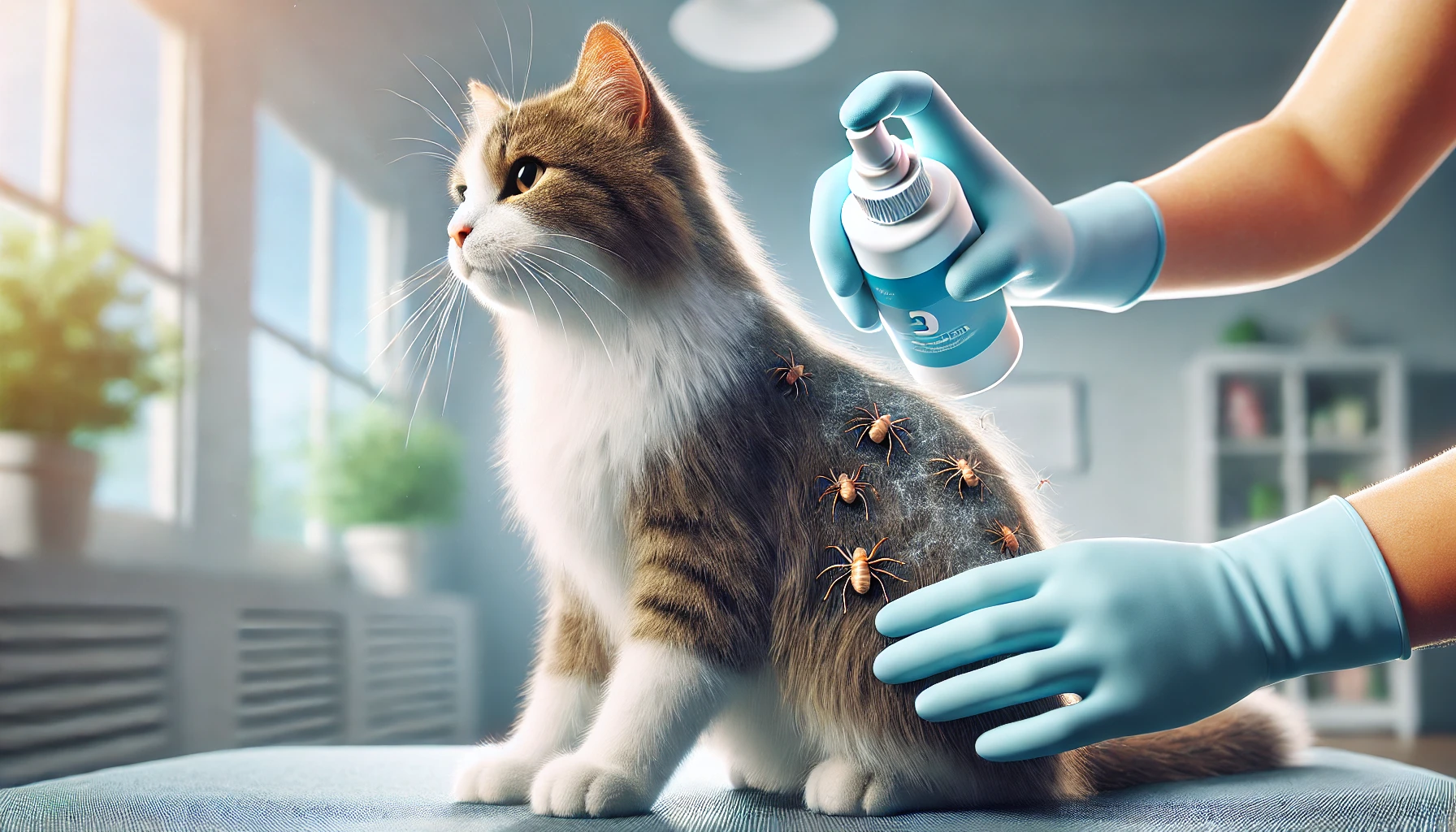
Effective Prevention and Treatment
Grooming alone is not enough to protect your cat from parasites.
Adding the right products, such as anti-parasitic shampoos or sprays, can enhance protection.
It’s also important to treat your surroundings, as fleas and other parasites can live in carpets, furniture, and bedding.
Cleaning your home thoroughly is essential when addressing an infestation.
In severe cases, it is advisable to seek veterinary help for stronger treatments or medications.
Over-the-counter remedies may not always be effective, and some can even be dangerous for cats, especially those formulated for dogs.
Professional guidance ensures your cat receives the correct and timely treatment.

Myths About Parasites
Several myths surround the issue of cat parasites, leading to misconceptions that can put your cat’s health at risk.
For example, many people believe that indoor cats are safe from parasites, but fleas, ticks, and other pests can still enter your home.
Fleas can survive for weeks without a host, making it important to treat both your pet and its environment.
Another common myth is that over-the-counter medications are always effective.
In reality, some products may not work as intended, and parasites can develop resistance to common treatments.
Consulting your vet ensures you choose the most effective and safest solution for your cat.

Maintaining Long-Term Health and Comfort
The best way to ensure your cat lives a healthy, parasite-free life is by being proactive.
Regular grooming, combined with preventive measures, can help keep parasites away.
Monitoring your cat for signs of parasites and acting promptly when they are detected can prevent more serious health issues from developing.
By following the steps outlined in this article, you can protect your cat from discomfort and the dangers caused by parasites.
Always seek professional help when necessary, and keep your home and your cat’s living environment clean to prevent future infestations.
By following a consistent grooming routine and using parasite prevention products, you can ensure your cat lives a healthy, parasite-free life.

FAQs for Cat Parasites During Grooming
Many cat owners have questions about detecting and preventing parasites in their feline friends.
Below are some of the most frequently asked questions about cat parasites, with concise answers to help maintain your cat’s health and keep them parasite-free.
How often should I groom my cat to check for parasites?
Groom your cat at least once a week, especially if they go outdoors, to check for parasites like fleas and ticks.
Longhaired cats may require more frequent grooming to maintain their coat and detect parasites quickly.
Can indoor cats get parasites like fleas and ticks?
Yes, indoor cats can still get parasites.
Fleas and ticks can enter your home through clothing, shoes, or other pets.
Regular grooming and parasite prevention treatments are necessary for indoor cats as well.
How do I remove a tick from my cat?
Use tweezers or a tick removal tool to carefully pull the tick straight out in a slow, steady motion without twisting.
Ensure you remove all parts of the tick, including the head, to avoid skin infection.
Can over-the-counter flea treatments harm my cat?
Some over-the-counter flea treatments, especially those for dogs, can be toxic or even fatal to cats.
Always consult your vet before using any flea medication to ensure it is safe and effective for your cat.
What are the symptoms of parasites in cats?
Common symptoms include excessive scratching, hair loss, skin redness, and visible fleas or flea dirt.
In severe cases, your cat may also appear lethargic or experience weight loss due to parasitic infections.





